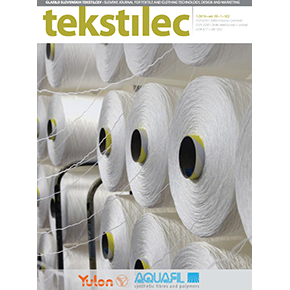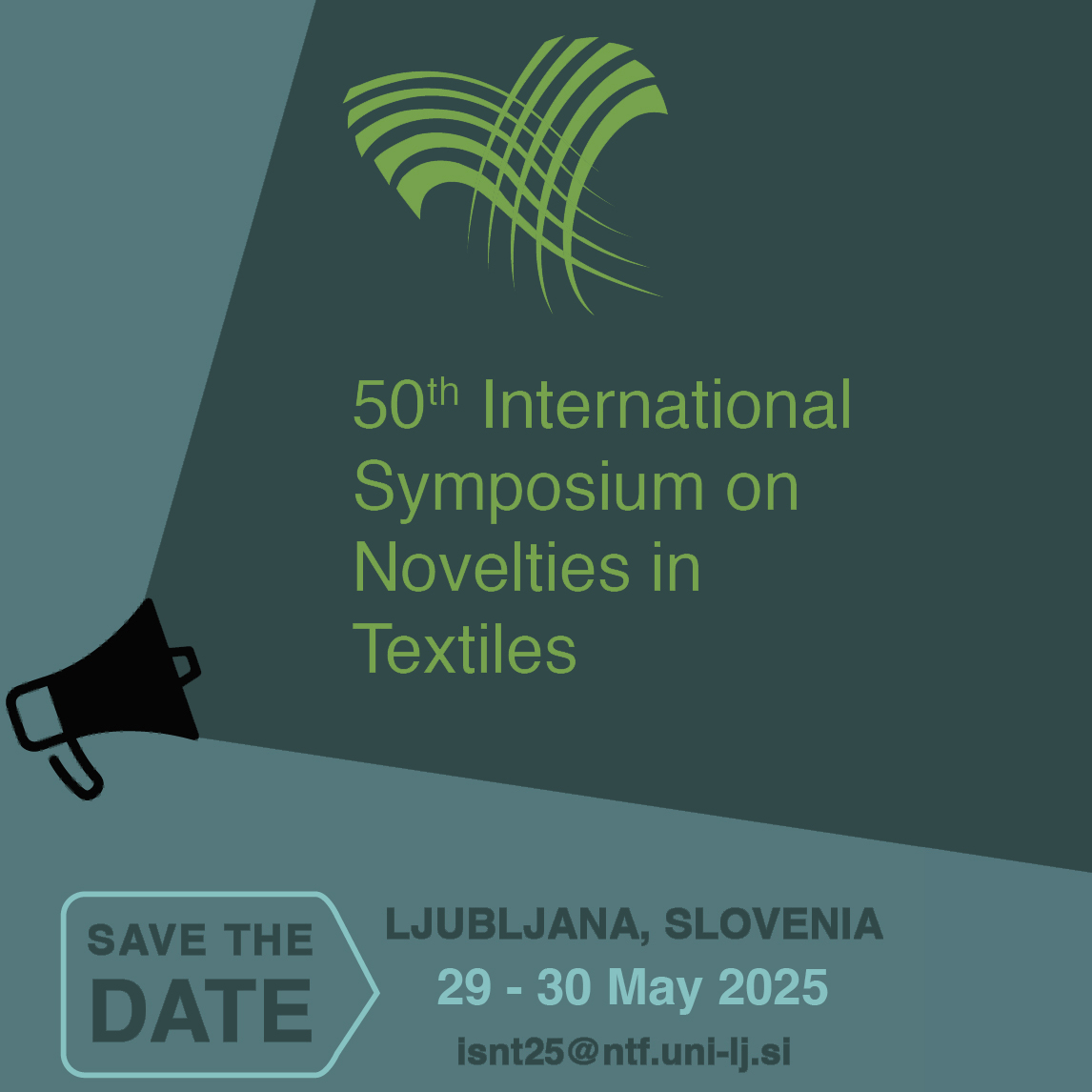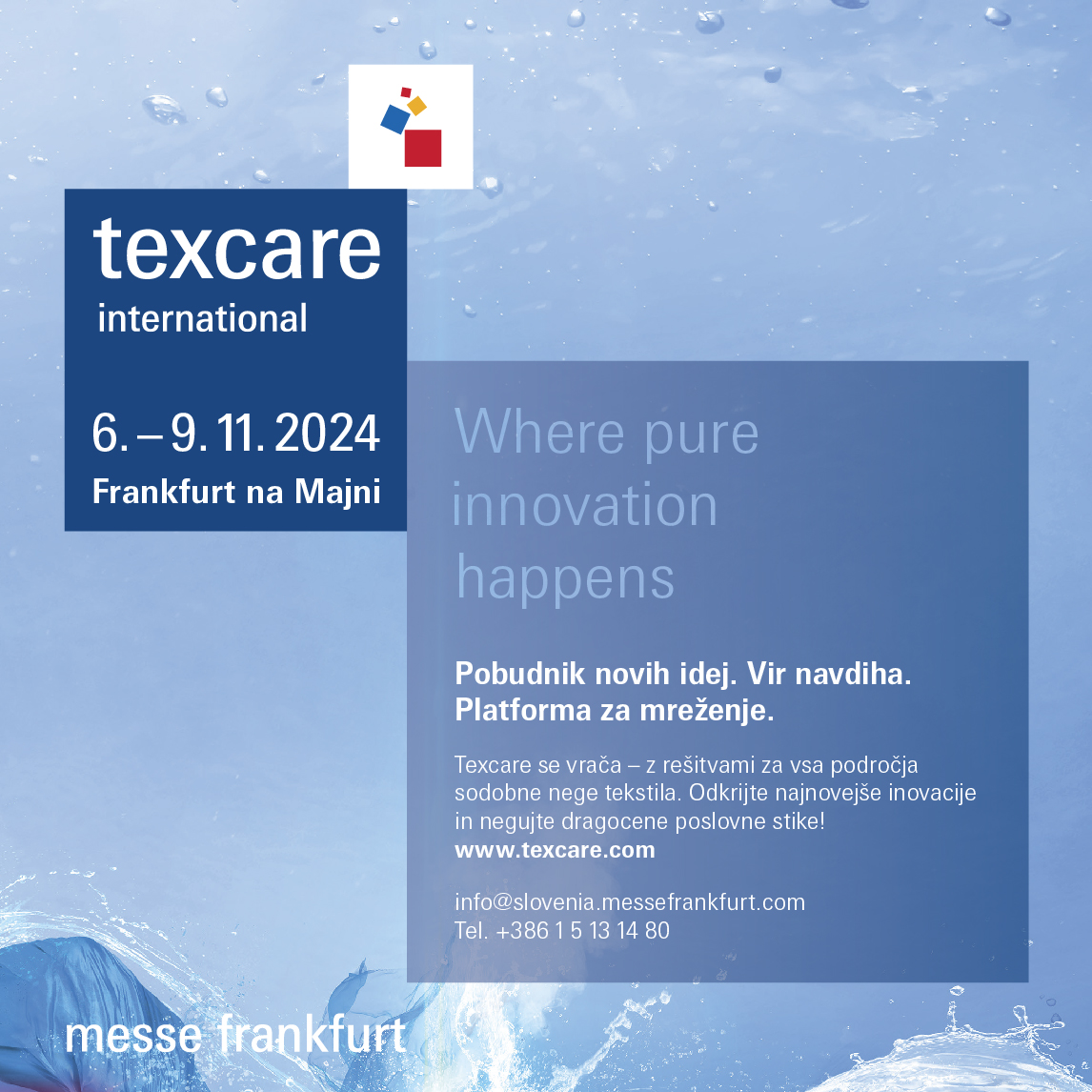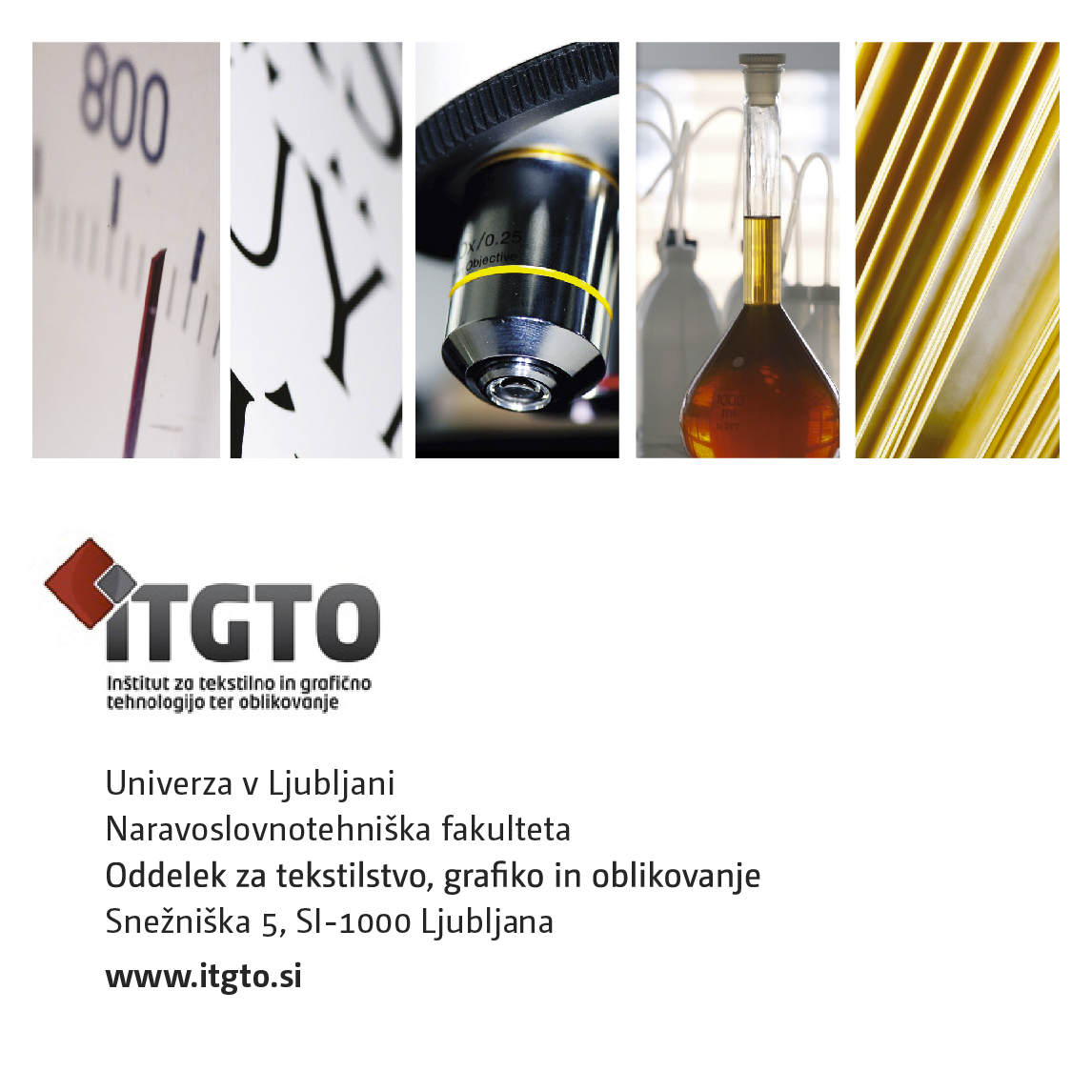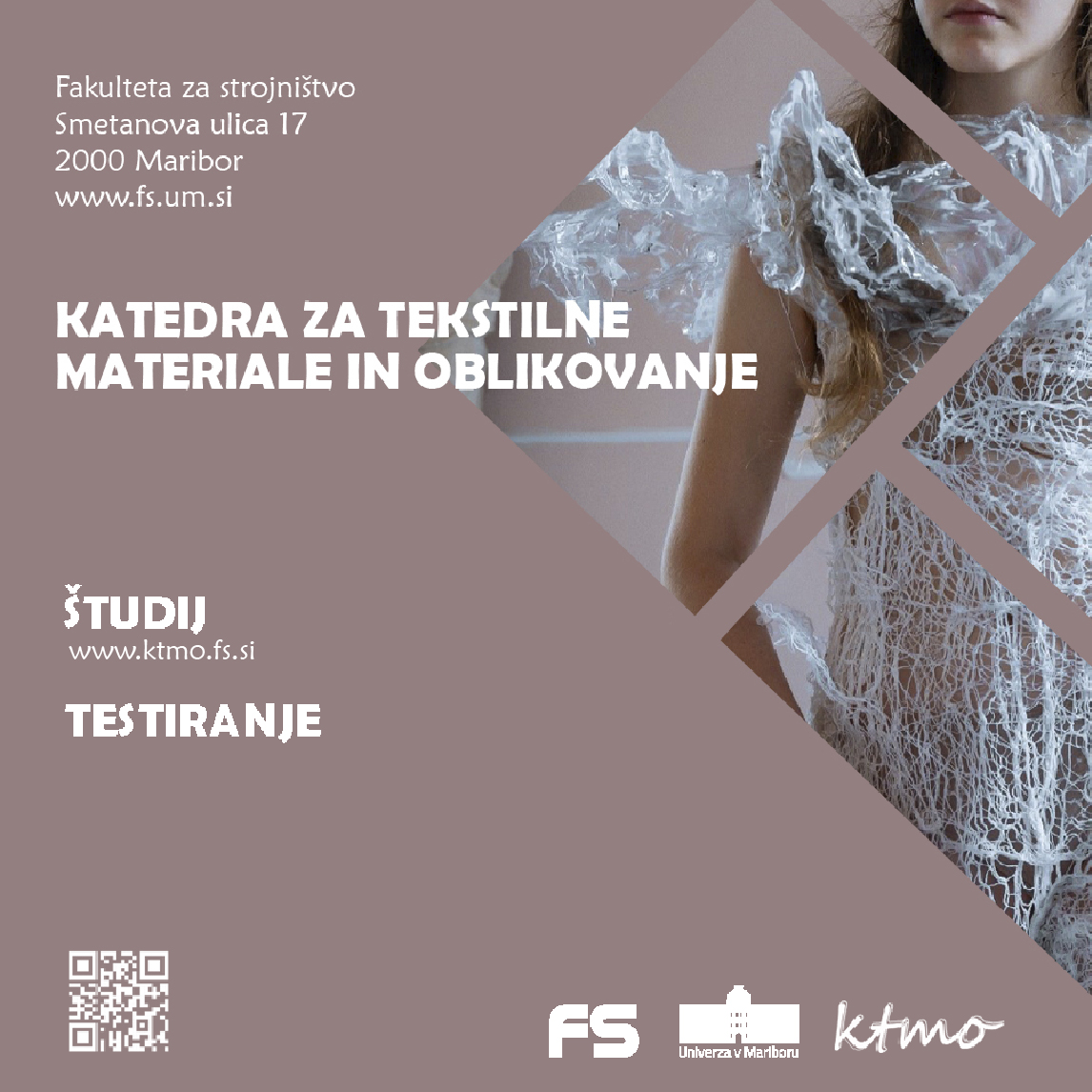Tekstilec, Vol. 59, 2016(1)
CONTENTS
SCIENTIFIC ARTICLE
4 Designing the Myth: Pattern Language to Assist with the Designing of Garments at the Drawing Stage
……..Jure Purgaj*, Simona Jevšnik** *** Abstract and references
*University for Teacher Education Vienna, Grenzackerstraße 18, AT-1100 Vienna
**INLAS d. o. o., Intelectual Property and Counseling d. o. o., Grajski trg 3, SI-3210 Slovenske Konjice
***University of Maribor, Faculty of Mechanical Engeneering, Institute of Engineering Materials and Design, Smetanova 17, SI-2000 Maribor
Original Scientific Article
Received 09-2015 • Accepted 12-2015
Corresponding author:
D.Sc. Jure Purgaj
E-mail: jure.purgaj@phwien.ac.at
Abstract
This article presents and introduces a new approach for researching into fashion, textile and clothing design. Following Christopher Alexander’s understanding of a pattern language the aim is to present and propose a pattern language which assists with the visualisations and designs of garments that use narrative, nonvisual forms as forms of inspiration. To visualise the descriptions of the Slovenian mythological creatures, a guided method for designing the garments was developed, based on fashion design practice and different proposed mythological patterns. Furthermore, the design components during the drawing process were defined and analysed. The abovementioned type of research is important in order to better understand the phases in the design process during drawing. On the basis of the gained results it can be concluded that the proposed pattern language and the guided method have great potential for creating new interdisciplinary knowledge. This developed method for visualising garments’ forms was tested on Slovenian mythological creatures but it could be used with any written texts. Moreover the method can also be used for educational purposes and further research into fashion design processes because it provides a classified environment that can be easily observed, analysed, and discussed.
Keywords: fashion design practice, visualisations, mythology, pattern language, narrative inspiration
References
- FRIEDMAN, Ken. Theory construction in design research: criteria: approaches, and methods. Design Studies, 2003, 24(6), 507–522. doi: 10.1016/s0142-694x(03)00039-5.
- CROSS, Nigel, PICAZZARO, Silvia, DE MORALES, Dijon, ARRUDA, Amilton. Designerly ways of knowing: design discipline versus design science. Design plus research, Proceedings of the Politenico di Milano conference. Milano : Politecnico di Milano, 2000, 43–48.
- FRAYLING, Christopher. Research in art and design. Royal College of Art Research Papers, 1993/4, 1(1), 1–5 [online] [accessed 19. 9. 2014]. Available on World Wide Web: <http://opensigle.inist.fr/handle/10068/492065>.
- FINDELI, Alain. Die Projektgeleitete Forschung. Erstes Design Forschungssyposim. Basel : Swissdesignnetwork, 2004, 40–52.
- JONAS, Wolfgang. Research through DESIGN through research: A cybernetic model of designing design foundations. Kybernetes. 2007, 36 (9/10), 1362–1380. doi: 10.1108/03684920710827355.
- BARTHES, Roland. Die Sprache der Mode. Frankfurt am Main : Suhrkamp Verlag, 1985.
- ZIMMERMAN, John, FORLIZZI, Jodi, EVENSON, Shelley. Research through design as a method for interaction design research in HCI. Proceedings of the SIGCHI conference on Human factors in computing systems – CHI ´O7. California, San Jose : ACM Press, 2007, 493–502.
- PURGAJ, Jure. Oblikovanje in vizualizacija oblačil slovenskih mitoloških bitij : doktorska disertacija. Ljubljana : Univerza v Ljubljani, NTF Oddelek za tekstilstvo, 2013.
- KROPEJ, Monika. Od ajda do zlatoroga: slovenska bajeslovna bitja. Ljubljana : Mohorjeva družba, 2008, p. 352.
- ANŽUR, Matjaž. Zgodovina slovenske mitologije. Ljubljana : samozaložba, Valuk, 2012.
- ŠMITEK, Zmago. Mitološko izročilo Slovencev: svetinje preteklosti. Ljubljana : Študentska založba, 2011, p. 428.
- RADENKOVIČ, Ljubinko. The appearance of mythological beings. Ljubljana : Studia Mythologica Slavica. 2009, 12, 153–168.
- BARNARD, Malcolm. Fashion as communication. New York : Routledge, 1996.
- KAWAMURA, Yuniya. Doing research in fashion and dress. New York : Berg, 2011, p. 192.
- ALEXANDER, Christopher. Notes on the synthesis of form. Harvard : Harvard University Press, 1964, p. 224.
- DOVEY, Kimberly. The pattern language and its enemies. Design studies. 1990, 11(1), 3–9, doi: 10.1016/0142-694x(90)90009-2.
- SAUNDERS, S. William. A Pattern Language: reviewed. Harvard Design Magazine. 2002, 16, 74–78.
- BHATT, Ritu. Christopher Alexander’s pattern language: an alternative exploration of space making practices. The Journal of Architecture. 2010, 15(6), 711–729, doi:10.1080/13602365.2011.533537.
- NOBLE, James. Towards a pattern language for object oriented design. Technology of Object-Oriented Languages. Melbourne, 1998, 2–13, [online] [accessed 23. 2. 2015]. Available on World Wide Web: <http://ieeexplore.ieee.org/xpl/login.jsp?tp=&arnumber=750020&url=http%3A%2F%2Fieeexplore.ieee.org%2Fiel4%2F6067%2F16205%2F00750020.pdf%3Farnumber%3D750020>.
- FINCHER, Sally. Patterns for HCI and cognitive dimensions: two halves ot the same story. Proceedings of the fourteenth annual workshop of the psychology of programming interest group, 2. Ed. by L. Baldwin and R. Scoble. London : Brunel University, 2002, 6, 156–172, [online] [accessed 29. 5. 2014]. Available on World Wide Web: <http://scholar.google.com/scholar?hl=en&btnG=Search&q=intitle:Patterns+for+HCI+and+Cognitive+Dimensions+:+two+halves+of+the+same+story+?#0>.
- DEARDEN, Andy, FINLAY, J. Pattern language in HCI: A critical review. Human-computer interaction. 2006, 21(1), 49–102, doi:10.1207/s15327051hci2101_3, [online] [accessed 19. 2. 2015]. Available on World Wide Web: <http://www.tandfonline.com/doi/abs/10.1207/s15327051hci2101_3>.
- PAUWELS Stefan L, HÜBSCHER, Christina, BARGAS-AVILA, Javier A, OPWIS, Klaus. Building an interaction design pattern language: A case study. Computers in Human Behavior. 2010, 26(3), 452–463, doi: 10.1016/j.chb.2009.12.004.
- DENEF, Sebastian, OPPERMANN, Reinhard, KEYSON, David V. Designing for social configurations: pattern languages to inform the design of ubiquitous computing. International Journal of Design, 2011, 5(3), 49–65.
- ALEXANDER, Christopher, ISHIKAWA, Sara, SILVERSTEIN, Murray, JACOBSON, Max, FIKSDAHL-KING, Ingrid, ANGEL, Shlomo. A Pattern Language. New York : Oxford University Press, 1977, p. 1171.
- ALEXANDER, Christopher. The timeless way of building complete. New York : Oxford University Press, 1979, p. 552.
- GAMMA, Erich, HELM, Richard, JOHNSONM, Ralph E., VLISSIDES, John. Design Patterns. Elements of Reusable Object-OrientedSoftware. Boston : Addison-Wesley, 1994, p. 416.
- BUSCHMANN, Frank, MEUNIER, Regine, ROHNERT, Hans, SOMMERLAD, Peter, STAL, Michael. Pattern-Oriented Software Architecture. West Sussex : John Wiley & Sons, 1996.
- PURGAJ, Jure, JEVŠNIK, Simona. Designing the myth: tag clouds – a tool for visualization of garment descriptions in mythological narratives. Tekstil, 2012, 61(7–12), 189–197.
- PODBREŽNIK VUKMIR, Breda, KOTNIK, Irena, STANONIK, Marija, DOBROVOLJC, Helena, LAMUT, Vera, SEKULIČ FO, Mojca. Čuden prečudež: folklorne in druge pripovedi iz Kamnika in okolice. Glasovi. Celje : Mohorjeva družba, 2009.
- Slovar slovenskega knjižnega jezika [online], [accessed 19.2.105]. Available on the World Wide Web: <http://bos.zrc-sazu.si/sskj.html/>.
- FLÜGEL, Charles John. The psychology of clothes. Broklyn : International Universities Press, 1971.
- Texsite.info [online], [accessed 19.2.2015]. Available on World Wide Web: <http://www.textsite.info/>.
- MCKELEVEY, Karthryn, MUNSLOW, Janine. Fashion design: process, inovation & practice. London : Wiley, 2012, p. 236.
- HOLLANDER, Anne. Seeing through clothes. New York : Wiking Press, 1978, p. 504.
15 Preparation of Multifunctional Repellent and Antimicrobial Active Polyamide 6
……..Fabric Pretreated with Oxygen Plasma
……..Barbara Rajar, Neža Sukič, Sandra Krebelj, Andrea Malnig, Milenko Čubrilović, Brigita Tomšič,
……..Marija Gorjanc, Barbara Simončič Abstract and References
University of Ljubljana, Faculty of Natural Sciences and Engineering, Department of Textiles, Graphic Arts and Design, Snežniška 05, SI-1000 Ljubljana
Original Scientific Article
Received 11-2015 • Accepted 01-2016
Corresponding author:
Prof. D.Sc. Barbara Simončič
E-mail: barbara.simoncic@ntf.uni-lj.si
Abstract
The aim of this study was to create the novel functional properties on polyamide 6 (PA 6) fabrics by the application of antimicrobially active AgCl particles and sol-gel finish with water- and oil-repellent properties. To increase adsorption abilities, the PA 6 fabric was treated by oxygen plasma for 30 seconds. Afterwards, in-situ synthesis ofAgCl particles was obtained by consecutive immersions of the fabric into 0.5mM solution of AgNO3 and NaCl, repeated twice. After drying 10% concentration of water- and oil-repellent perfluorotrialkoxysilane (FAS) was applied on the PA 6 fabric using the impregnation method. For comparison, dual-component finish was also applied on a PA 6 fabric without plasma-treatment. Using the same conditions, one-component finishes were prepared as well. The finished samples were washed five-times in a Launderometer at 40°C according to the standard method, whereas one washing cycle corresponded to five domestic washings. Functional properties were determined by measuring static contact angles of water and n-hexadecane, sliding angles of water, and by qualitative evaluations of microorganisms’ growths on the studied samples after deposition of raw milk. The results showed that plasma treatment and the application of finishes influenced the morphological and chemical properties of the fibres. AgCl particles, which were formed during in-situ synthesis, were clearly seen on the surfaces of the finished samples. The presence of FAS resulted in an increase of the static contact angles of the water and n-hexadecane, which led to the creation of hydrophobic and oleophobic properties of the fabric. The finished fabric did not show selfcleaning properties as sliding angles of water greater than 10° were obtained. The presence of the AgCl particles did not affect the repellent properties of the fabric but importantly influenced the growth reductions of the microorganisms on the fibres, which resulted in less intensive odour of the samples after the deposition of raw milk. On the other hand, the presence of FAS decreased leaching of silver into the surroundings, which influenced the increase of the washing durability of the AgCl particles and was thus reflected in the antimicrobial activity of the fibres even after five consecutive washings. This confirmed the synergistic activity of AgCl particles and FAS in dual- component finishing. Plasma treatment did not influence the adsorption ability of the fabric but did improve the adhesion of the studied finishes and thus significantly enhanced their washing durability on the PA 6 fabric.
Keywords: polyamide 6, water- and oil-repellency, antimicrobial activity, sol-gel, plasma, nano silver
References
- SIMONČIČ, Barbara, TOMŠIČ, Brigita, OREL, Boris, JERMAN, Ivan. Tekstilija kot navdih iz narave. Tekstilec, 2010, 5(10/12), 294–306.
- SIMONČIČ, Barbara, TOMŠIČ, Brigita, VASILJEVIĆ, Jelena. Nanokompozitna apretura sol-gel. Tekstilec, 2013, 56(2), 159–165.
- BRINKER, C. Jeffrey, SCHERER, W. George. Sol-gel science : the physics and chemistry of sol-gel processing. San Diego : Academic Press, 1990, 908 str.
- Handbook of organic-inorganic hybrid materials and nanocomposites. Uredila Hari Singh NALWA. Stevenson Ranch : American Scientific Publisher, 2003, 386 str.
- SIMONČIČ, Barbara. Hydrophobic & oleophobic protection. V: BISCHOF VUKUŠIĆ, Sandra (ur.). Functional protective textiles. Zagreb: University of Zagreb, Faculty of Textile Technology, 2012, 145–170.
- SIMONČIČ, Barbara, TOMŠIČ, Brigita, ČERNE, Lidija, OREL, Boris, JERMAN, Ivan, KOVAČ, Janez, ŽERJAV, Metka, SIMONČIČ, Andrej. Multifunctional water and oil repellent and antimicrobial properties of finished cotton: influence of sol-gel finishing procedure. Journal of Sol-Gel Science and Technology, 2012, 61(2), 340–354, doi: 10.1007/s10971-011-2633-2.
- VASILJEVIĆ, Jelena, TOMŠIČ, Brigita, JERMAN, Ivan, OREL, Boris, JAKŠA, Gregor, SIMONČIČ, Barbara. Novel multifunctional water- and oil- repellent, antibacterial, and flame-retardant cellulose fibres created by the sol-gel process. Cellulose, 2014, 21(4), 2611–2623, doi: 10.1007/s10570-014-0293-4.
- TOMŠIČ, Brigita, SIMONČIČ, Barbara, OREL, Boris, ČERNE, Lidija, FORTE-TAVČER, Petra, ZORKO, Mateja, JERMAN, Ivan, VILČNIK, Aljaž, KOVAČ, Janez. Sol-gel coating of cellulose fibres with antimicrobial and repellent properties. Journal of Sol-Gel Science and Technology, 2008, 47(1), 44–57, doi: 10.1007/s10971-008-1732-1.
- MAHLTIG, Boris, FISCHER Anja. Inorganic/organic polymer coatings for textiles to realize water repellent and antimicrobial properties ‒A study with respect to textile comfort. Journal of Polymer Science Part B-polymer Physics, 2010, 48(14), 1562–1568, doi: 10.1002/polb.22051.
- SIMONČIČ, Barbara, TOMŠIČ, Brigita. Structures of novel antimicrobial agents for textiles. Textile Research Journal, 2010, 80(16), 17212–1737, doi: 10.1177/0040517510363193.
- SIMONČIČ, Barbara, KLEMENČIČ, Danijela. Preparation and performance of silver as an antimicrobial agent for textiles : a review. Textile Research Journal, 2015, 86(29), 210‒223, doi: 10.1177/0040517515586157.
- RADETIĆ, Maja. Functionalization of textile materials with silver nanoparticles. Journal of Materials Science, 2013, 48(1), 95–107, doi: 10.1007/s10853-012-6677-7.
- KLEMENČIČ, Danijela, TOMŠIČ, Brigita, KOVAČ, Franci SIMONČIČ, Barbara. Antimicrobial cotton fibres prepared by in situ synthesis of AgCl into a silica matrix. Cellulose, 2012, 19(5), 1715–1729, doi: 10.1007/s10570-012-9735-z.
- KLEMENČIČ, Danijela, TOMŠIČ, Brigita, KOVAČ, Franci, ŽERJAV, Metka, SIMONČIČ, Andrej, SIMONČIČ, Barbara. Antimicrobial wool, polyester and a wool/polyester blend created by silver particles embedded in a silica matrix. Colloids and Surfaces. B, Biointerfaces, 013, 111(1), 517–522, doi: 10.1016/j.colsurfb.2013.06.044.
- KLEMENČIČ, Danijela, TOMŠIČ, Brigita, KOVAČ, Franci, ŽERJAV, Metka, SIMONČIČ, Andrej, SIMONČIČ, Barbara. Preparation of novel fibre-silica-Ag composites: the influence of fibre structure on sorption capacity and antimicrobial activity. Journal of Materials Science, 2014, 49(10), 3785–3794, doi: 10.1007/s10853-014-8090-x.
- GORJANC, Marija, GORENŠEK, Marija. Cotton functionalization with plasma. Tekstil, 2010, 59(1/2), 11–19.
- CANAL, Cristina. Low temperature plasma treatments of textiles. Journal of Microelectronics Electronic Components and Materials, 2008, 38(4), 244‒251.
- GORJANC, Marija, BUKOŠEK, Vili, GORENŠEK, Marija, VESEL, Alenka. The influence of water vapor plasma treatment on specific properties of bleached and mercerized cotton fabric. Textile Research Journal, 2010, 80(6), 557–567, doi: 10.1177/0040517509348330.
- GORENŠEK, Marija, GORJANC, Marija, KOVAČ, Janez. Preiskava kemijskih sprememb na površini PET pletiva z rentgensko fotoelektronsko spektroskopijo po obdelavi s korona plazmo in po staranju pletiva. Tekstilec, 2010, 53(4/6), 103–112.
- GORJANC, Marija, KOVAČ, Janez, GORENŠEK, Marija. Rentgenska fotoelektronska spektroskopija za določanje kemijskih sprememb na površini bombaža po obdelavi s korona in nizkotlačno plazmo. Tekstilec, 2010, 53(7/9), 194–204.
- RIJAVEC, Tatjana. Tekstilne surovine. Osnove. Ljubljana : Naravoslovnotehniška fakulteta, Oddelek za tekstilstvo, 2000, 145 str.
- GRUSZKA, I., LEWANDOWSKI, S., BENKO, E., PERZYNA M. Structure and mechanical properties of polyamid fibres. Fibres & Textiles in Eastern Europe, 2005, 13(5/53), 133–136.
- YIP, Joanne, CHAN, Kwong, SIN, Kwan Moon, LAU, Kai Shui. Low temperature plasma-treated nylon fabrics. Journal of Materials Processing Technology, 2002, 123(1), 5–12, doi: 10.1016/s0924-0136(02)00024-9.
- ILIĆ, Vesna, ŠAPONJIĆ, Zoran, VODNIK, Vesna, MOLINA, Ricardo, DIMITRIJEVIĆ, Suzana, JOVANČIĆ, Petar, NEDELJKOVIĆ, Jovan, RADETIĆ, Maja. Antifungal efficiency of corona pretreated polyester and polyamide fabrics loaded with Ag nanoparticles. Journal of Material Sciences, 2009, 44(15), 3983–3990, doi: 10.1007/s10853-009-3547-z.
- RASLAN, W. M., EL-KHATIB, E. M., EL-HALWAGY, A. A., GHALAB, S. Low temperature plasma/metal salts treatments for improving some properties of polyamide 6 fibers. Journal of Industrial Textiles, 2011, 40(3), 246–260, doi: 10.1177/1528083710371488.
- ZILLE, Andrea, FERNANDES, M. Margarida, FRANCESKO, Antonio, TZANOV, Tzanko, FERNANDE,S Marta, FERNANDO, R. Oliveira, ALMEIDA, Luís, AMORIM, Teresa, CARNEIRO, Noémia, ESTEVES, F. Maria, SOUTO, P. António. Size and aging effects on antimicrobial efficiency of silver nanoparticles coated on polyamide fabrics activated by atmospheric DBD plasma. ACS Applied Materials & Interfaces, 2015, 7(25), 13731−13744, doi: 10.1021/acsami.5b04340.
- HAJI, Aminoddin, SHOUSHTARIB, Mousavi Ahmad, MIRAFSHARB, Maryam. Natural dyeing and antibacterial activity of atmospheric-plasma-treated nylon 6 fabric. Coloration Technology, 2013, 130(1), 37–42, doi: 10.1111/cote.12060.
- NOVÁK, I., POPELKA, A., VALENTÍN, M., CHODÁK I., ŠPÍRKOVÁ, M., TÓTH, A., KLEINOVÁ ,A., SEDLIAČIK, J., LEHOCKÝ, M., MARÔNEK, M. Surface behavior of polyamide 6 modified by barrier plasma in oxygen and nitrogen. International Journal of Polymer Analysis and Characterization, 2014, 19(1), 31–38, doi: 10.1080/1023666x.2014.850907.
- MAHLTIG, Boris, TEXTOR, Torsten. Silver containing sol-gel coatings on polyamide fabrics as antimicrobial finish-description of a technical application process for wash permanent antimicrobial effect. Fibers and Polymers, 2010, 11(8), 1152–1158, doi: 10.1007/s12221-010-1152-z.
- DAMM, Cornelia, MÜNSTEDT, Helmut, RÖSCH, Alfons. Long-term antimicrobial polyamide 6/silver-nanocomposites. Journal of Materials Science, 2007, 42(25), 6067–6073, doi:10.1007/s10853-006-1158-5.
- DAMM, Cornelia, MÜNSTEDT, Helmut, RÖSCH, Alfons. The antimicrobial efficacy of polyamide 6/silver-nano- and microcomposites. Materials Chemistry and Physics, 2008, 108(1), 61–66, doi: 10.1016/j.matchemphys.2007.09.002.
- EREM, Aysin Dural, OZCAN, Gulay, SKRIFVARS, Mikael, CAKMAK, Mukerrem. In vitro assesment of antimicrobial activity and characteristics of polyamide 6/silver nanocomposite fibers. Fibers and Polymers, 2013, 14(9), 1415–1421, doi: 10.1007/s12221-013-1415-6.
- GERBER, Lukas C., MOHN, Dirk, FORTUNATO, Giuseppino, ASTASOV-FRAUENHOFFER, Monika, IMFELD, Thomas, WALTIMO, Tuomas, ZEHNDER, Matthias, STARK, Wendelin J. Incorporation of reactive silver-tricalcium phosphate nanoparticles into polyamide 6 allows preparation of self-disinfecting fibers. Polymer Engineering & Science, 2011, 51(1), 71–77, doi: 10.1002/pen.21779.
- LEE, Duk Hyung, MIN, Byung Gil. Preparation and antibacterial properties of nanocomposite fibers made of polyamide 6 and silver-doped hydroxyapatite. Fibers and Polymers, 2014, 15(9), 1921‒1926, doi: 10.1007/s12221-014-1921-1.
- MONTAZER, Majid, SHAMEI, Ali, ALIMOHAMMADI, Farbod. Synthesis of nanosilver on polyamide fabric using silver/ammonia complex. Materials Science and Engineering C, 2014, 38, 170–176, doi: 10.1016/j.msec.2014.01.044.
- MAHLTIG, Boris, BÖTTCHER, Horsten. Modified silica sol coatings for water-repellent textiles. Journal of Sol-Gel Science and Technology, 2003, 27(1), 43–52, doi: 10.1023/a:1022627926243.
- SOCRATES, George. Infrared and raman characteristic group frequences. Chister, New York, Weinheim, Toronto, Brisbane, Singapore : John Wiley & Sons, 2004, 347 str.
- GORJANC, Marija, TOMŠIČ, Brigita, MANDELJ, Tina, KURENT, Rahela, ZDOVC, Kristina, DREVENŠEK, Katarina, PAJSAR, Nina, KERT, Mateja, SIMONČIČ, Barbara. Oblikovanje superhidrofobne in oleofobne bombažne tkanine, pobarvane z reaktivnimi barvili. Tekstilec, 2014, 57(4), 273‒282, doi: 10.14502/Tekstilec2014.57.273−282.
28 3D Visualisation of Woven Fabric Porosity
……..Tanja Nuša Kočevar, Helena Gabrijelčič Tomc Abstract and References
University of Ljubljana, Faculty of Natural Sciences and Engineering, Department of Textiles, Graphic Arts and Design, Snežniška 05, SI-1000 Ljubljana
Original Scientific Article
Received 08-2015 • Accepted 02-2016
Corresponding author:
Asist. D.Sc. Tanja Nuša Kočevar
E-mail: tanja.kocevar@ntf.uni-lj.si
Abstract
The aim of the research was to analyse the influence of texture preparation for 3D visualisation of woven fabric porosity, i.e. the analysis of the lighting influence while taking photographs of a fabric and the analysis of histogram threshold methods for the alpha map preparation. We introduced the process for the 3D visualisation of porous textile structures, which included image information and image analysis for the generation of accurate information about pores. We analysed a woven fabric used for “rokavci”, which is a part of a folk costume originating from the Gorenjska region. The fabric with visible signs of being wornout is woven in plain weave and the pores between warp and weft threads are rather uneven considering their size and shape. For a realistic 3D visualisation, image information about pores is extremely important; therefore, the process of texture preparation for the 3D visualisation of fabric porosity was defined, including the process of image analysis and 3D visualisation. The fabric was photographed at 7 different lighting schemes. Using the application ImageJ for image analysis, the pictures were processed with 3 various threshold methods, i.e. Yen algorithm, the method for defining the local minimum between histogram peaks and the method with a manual (visual) definition of the threshold. As a result, various images – alpha maps – were obtained and used for the 3D visualisation of fabric porosity. We also implemented the image analysis of pore sizes, their number and the area coverage of pores. The results showed dependency of image information quality on the type and manner of lighting, where the type of lights was predominantly important (diffuse light, direct light), followed by the number of lights, their placement and their combination. Furthermore, it was also established that for the 3D visualisation of the fabric with a distinctly uneven structure, the use of alpha maps created with the method of manual (visual) definition of histogram threshold is the most suitable.
Keywords: woven fabric porosity, 3D visualisation, image analysis, alpha map, histogram threshold
References
- DORSEY, Julie, RUSHMEIER, Holly, SILLION, François X. Digital modeling of material appearance. 1. izdaja. Burlington . Morgan Kaufmann/Elsevier, 2007, str. 147–150.
- GABRIJELČIČ TOMC, Helena. Barva in optični pojavi na tkanini = Colour and optical phenomena on fabric. Tekstilec, 2007, 50(4/6), 93–132.
- ERZETIČ, Blaž, GABRIJELČIČ Helena. 3D od točke do upodobitve. 2. izdaja. Ljubljana : Pasadena, 2010, str. 89–91.
- GRÖLLER, Eduard, RAU, T. René, STRASSER, Wolfgang. Modeling textiles as three dimensional textures. V: Rendering Techniques ’96. Proceedings of the Eurographics Workshop. Uredila X. Pueyo in P. Schröder. Porto : Eurographics, Wien, NewYork : Springer, 1996, str. 205–214.
- KAJIYA, T. James, KAY, L. Timoty. Rendering fur with three dimensional textures. V: Proceedings of the 16th annual conference on Computer graphics and interactive techniques. New York : ACM SIGGRAPH, 1989, 271–280, doi: 10.1145/74333.74361.
- XU, Ying-Qing, CHEN, Yanyun, LIN, Stephen, ZHONG, Hua, WU, Enhua, GUO, Baining, SHUM, Heung-Yeung. Photorealistic rendering of knitwear using the lumislice. V: Computer graphics and interactive techniques. New York : ACM SIGGRAPH, 2001, 391–398, doi: 10.1145/383259.383303.
- PERLIN, Ken, HOFFERT, Eric M. Hypertexture. V: Computer graphics and interactive techniques, New York : ACM SIGGRAPH, 1989, 23(3), 253–262.
- CYBULSKA, Maria. Reconstruction of archeological textiles. Fibres & Textiles in Eastern Europe, 2010, 18(3(80)), 100–105.
- XIN, Binjie, HU, Jinlian, BACIU, George. Visualisation of textile surface roughness based on silhouette image analysis. Textile Research Journal, 80(2) 2010, 166–176, doi: 10.1177/0040517508093779.
- ZHAO, Shuang, JACOB, Wenzel, MARCHNER, Steve, BALA, Kavita. Building volumetric appearance models of fabric using micro CT imaging. Communications of the ACM, 2014, 57(11), 98–105, doi: 10.1145/2670517.
- DANA, J. Kristin, GINNEKEN van Bram, NAYAR, K. Shree, KOENDRINK, J. Jan. Reflectance and texture of real-world surfaces. ACM Transactions on Graphics, 1999, 18(1), 1–34.
- TORRANCE, E. Kenneth, SPARROW, M. Ephraim. Theory for off-specular reflection from roughened surfaces. Journal of the Optical Society of America, 1967, 57(9), 1105–1112, doi: 10.1364/JOSA.57.001105.
- YASUDA, Takami, YOKOI, Shigeki, TORIWAKI, Jun-ichiro, INAGAKI, Katsuhiko. A shading model for cloth objects. Computer Graphics and Applications, IEEE 1992, 12(6), 15–24, doi: 10.1109/38.163621.
- HAVLOVÁ, Marie. Model of vertical porosity occuring in woven fabrics and its effect on air permeability. Fibres & Textiles in Eastern Europe, 2014, 22(4(106)), 58–63.
- MILITKÝ, Jiří, HAVRDOVÁ, Marie. Porosity and air permeability of composite clean room textiles. International Journal of Clothing Science and Technology, 2001, 13(3/4), 280–289, doi: 10.1108/09556220110396533.
- GOOIJER, Henk, WARMOESKERKEN, M.C.G. Marijn, GROOT WASSINK, J. Flow resistance of textile materials – Part I: Monofilament fabrics. Textile Research Journal, 2003, 73(5), 437–443, doi: 10.1177/004051750307300511.
- ROBERTSON, A.F. Air porosity of open-weave fabric. Textile Research Journal, 1950, 20(12), 838–857, doi: 10.1177/004051755002001203.
- LU, Wei-Ming, TUNG, Kuo-Lun, HWANG, Kuo-Jen. Fluid flow through basic weaves of monofilament filter cloth. Textile Research Journal, 1996, 66(5), 311–323, doi: 10.1177/004051759606600505.
- HAVRDOVÁ, Marie. Air permeability and a structure of woven fabrics. Vlákna a Textil, 2003, 10(2), 86–90.
- DUBROVSKI DOBNIK, Polona. Volume porosity of woven fabrics. Textile Research Journal, 2000, 70(10), 915–919, doi: 10.1177/004051750007001011.
- ZUPIN, Živa, HLADNIK, Aleš, DIMITROVSKI, Krste. Prediction of one-layer woven fabrics air permeability using porosity parameters. Textile Research Journal, 2012, 82(2), 117–128, doi: 10.1177/0040517511424529.
- OGULATA, R. Tugrul, MEZARCIOZ, (Mavruz) Serin. Total porosity, theoretical analysis, and prediction of the air permeability of woven fabrics. The Journal of The Textile Institute, 2012, 103(6), 654–661, doi: 10.1080/00405000.2011.597567.
- JAKŠIĆ, Danilo, JAKŠIĆ, Nikola. Assessment of porosity of flat textile fabrics. Textile Research Journal, 2007, 77(2), 105–110, doi: 10.1177/0040517506065892.
- KANG, Jin Tae, CHOI, Soo Hyun, KIM, Sung Min, OH, Kyung Wa. Automatic structure analysis and objective evaluation of woven fabric using image analysis. Textile Research Journal, 2001, 71(3), 261–270, doi: 10.1177/004051750107100312.
- CARDAMONE, M. Jeanette, DAMERT, C. William, PHILLIPS, C. John, MARNER, N. William. Digital image analysis for fabric assessment. Textile Research Journal, 2002, 72(10), 906–916, doi: 10.1177/004051750207201009.
- TÀPIAS, Montserrat, RALLÓ, Miquel, ESCOFET, Escofet, ALGABA, Inés, RIVA, Ascensión. Objective measure of woven fabric’s cover factor by image processing. Textile Research Journal, 2010, 80(1), 35–44, doi: 10.1177/0040517509104471.
- AYDILEK, H. Ahmet, OGUZ, H. Seyfullah, EDIL, B. Tuncer. Digital image analysis to determine pore opening size distribution of nonwoven geotextiles. Journal of Computing in Civil Engineering, 2002, 16(4), 280-290, doi: 10.1061/(asce)0887-3801(2002)16:4(280).
- NAGLIČ, Barbara, KOČEVAR, Tanja Nuša, GABRIJELČIČ TOMC, Helena. Digitalna vizualizacija gorenjske ljudske noše. Tekstilec, 2015, 58(1), 67–79.
- HLADNIK, Aleš, MUCK, Tadeja. Obdelava digitalnih slik v grafiki - Prvi del. Uredila D. Gregor Svetec. Ljubljana : Univerza v Ljubljani, Naravoslovnotehniška fakulteta, 2010, str. 18‒32.
- YEN, Jui-Cheng, CHANG, Fu-Juay , CHANG, Shyang. A new criterion for automatic multilevel thresholding. IEEE Transactions on Image Processing, 1995, 4(3), 370–378, doi: 10.1109/83.366472.
- SEZGIN, Mehmet, SANKUR, Bülent. Survey over image thresholding techniques and quantitative performance evaluation. Journal of Electronic Imaging, 2004, 13(1), 146–165, doi: 10.1117/1.1631315.
PROFESSIONAL ARTICLES
41 Space in Fashion Design based on Architectural Works by Maks Fabiani –
……..Ƒ2 (Fabiani Fashion) Case Study
……..Tanja Devetak Abstract and References
Faculty of Design, Associated member of University of Primorska, Prevale 10, SI-1236 Trzin
Professional Article
Received 10-2015 • Accepted 02-2016
Corresponding author:
Assist. Prof. Tanja Devetak
E-mail: tanja.devetak@siol.net
Abstract
The article Space in Fashion Design based on Architectural Works by Maks Fabiani has been prepared on the basis of the case study of the JF2 project (Fabiani Fashion) in which the architectural objects of Maks Fabiani and the understanding of space of the objects in historical context, aesthetical perception, psychological detection, social relations and stylistic manifestations are transferred into clothing forms. Space is a dimension which depends on the viewing angle of the observer. It has a material value (physical dimension) and a philosophical concept (abstract dimension). In the development of an architectural concept, unlike fashion design, the principle of universality is implemented, because the longevity of architecture is a very important factor. The JF2 case study (Fabiani Fashion) combines complex architectural and urban spatial solutions of Maks Fabiani in contemporary versions of wearable garments. It explores and transforms the architectural structures into visual images of clothing using creative construction techniques for creating forms on tailors’ dummy and for designing textile patterns. The resulting clothing forms visually articulate the meanings arising from the content inside the premises, historical context, personal sensory experiences and structures of architectural design work of the architect and urbanist Maks Fabiani. The JF2 case study (Fabiani Fashion) presents clothing design images that reflect inspirational influences of the selected architectural solutions of Maks Fabiani in Ljubljana, Slovenia. The selected architectural and urban solutions include Hribar House, Bamberg House, Krisper House, Jakopič Pavillion, City Almshouse and Miklošič Park.
Keywords: space, fashion, architecture, Maks Fabiani, creative construction
References
- FISCHER, Anette. Basics fashion design 03: Construction. Lausanne: AVA Publishing, 2009.
- ÜNGÜR, Erdem. Space : the undefinable space of architecture [dostopno na daljavo], Academia [citirano 24. 9. 2015]. Dostopno na svetovnem spletu: <http://www.academia.edu/2061334/Space_The_undefinable_space_of_archite cture>.
- HRAUSKY, Andrej, KOŽELJ, Janez. Maks Fabiani : Dunaj, Ljubljana, Trst. 1. izdaja. Ljubljana: Cankarjeva založba, 2010, 189 str.
- LINDQVIST, Rickard. Kinetic garment construction. Remarks on the fundations of pattern cutting. Studies in Artistic Research No. 13 [dostopno na daljavo], Uredil Lars Hallnäs. Borås : University of Borås, 2015 [citirano 24. 9. 2015]. Dostopno na svetovnem spletu: <http://www.hb.se/Global/BLR/Nyheter/rickard_lindqvist_diss.pdf>.
- RISSANEN, Timo. Zero-waste fashion design : a study at the intersection of cloth, fashion design and pattern cutting [dostopno na daljavo], PhD Thesis Sydney : University of Technology, 2013 [citirano 24. 9. 2015]. Dostopno na svetovnem spletu: <https://opus.lib.uts.edu.au/handle/10453/23384>.
- SEVIN-DOERING, Geneviève. Un vetement autre [dostopno na daljavo], [citirano 28. 9. 2015]. Dostopno na svetovnem spletu: <http://sevindoering.free.fr>.

